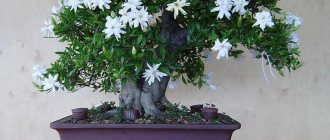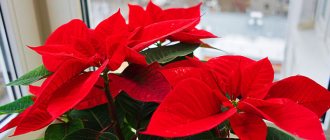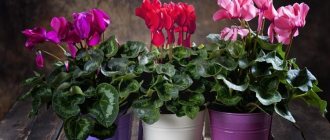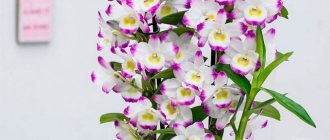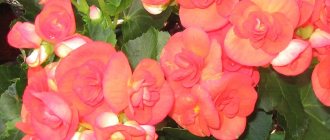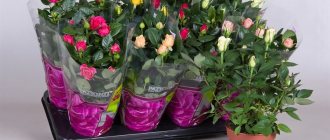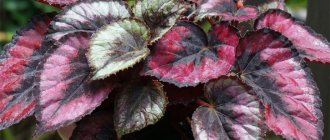Author: Elena N. https://floristics.info/ru/index.php?option=com_contact&view=contact&id=19 Category: Houseplants Published: October 24, 2017Last edits: January 11, 2021
Azalea (lat. Azalea) is the common name for some beautifully flowering species of the genus Rhododendron, which were previously classified as a separate genus of the Heather family. Actually, these are the same rhododendrons, only indoors. In nature, there are about 350 representatives of azaleas, but only two species are grown indoors. Azaleas are native to China and Japan, but today they can be found in Europe and North America. The generic name "rhododendron" consists of two Greek words that are translated as "rose" and "tree", that is, "rose tree". And “azalea” translated means “dried, waterless”: in nature, azalea is a small dry shrub. Azalea appeared in cultivation in the 17th century, and by 1820 the first varieties of the plant were bred, of which there were already more than a thousand by the beginning of the last century.
How do you care for a flower in a store?
When choosing an azalea in a store, it is important not only to choose a healthy plant, but also to ask the seller in detail about what kind of care it was provided with . This is necessary to create the most comfortable conditions for the flower immediately after the move. In addition, having advance information about the nuances of care, you can always predict the prospects for the successful adaptation of a particular plant.
As a rule, azaleas are delivered to the store in small plastic containers filled with a special nutrient substrate that can fully provide the plant with nutrition throughout its sale. Sellers can only provide the plant with a comfortable temperature regime, proper watering and sufficient humidity.
Important! However, some unscrupulous supplier-manufacturers place young rhododendrons in obviously low-quality “poor” soil and “drive out” the buds by using specialized chemicals.
In such a situation, the azalea, which is actually dormant, releases buds, throwing all its strength at it, while its root system begins to seriously lag behind in development. In most cases, specimens treated in this way are doomed to death, so if you purchase them, you need to take a serious approach to “reanimating” the depleted plant.
In order to fully enjoy the beauty and long life of the purchased azalea, you should carefully study the plant before purchasing :
- The planting container should not be too spacious or too cramped for a particular specimen. The plant should sit fairly tightly in the bowl and not wobble.
- There should be no plaque or mold on the surface of the soil, as well as on the bottom of the pot. The soil should not emit an unpleasant odor.
- The soil should not be too dry or too wet, otherwise you risk purchasing a plant with an injured root system.
- Large dark green leaves may indicate overfeeding, so it is best to choose a bush with small light green leaves.
- There should be no visible signs of pest damage on the back of the leaves (cobwebs, spots, insects, etc.)
It is better if the plant is just picking up buds or is already faded, because specimens arriving in the active flowering phase adapt to new conditions longer and more painfully .
When purchasing, it is best to give preference to medium-sized azaleas, because... a specimen that is too large will take a long time to adapt to new conditions, while a very small and poorly formed shrub may subsequently prove unviable.
Do I need to replant an azalea?
Changing the soil and flowerpot is necessary if necessary. A three-year-old crop is replanted once a year. If the plant is older, the procedure is done 2 times a year. The flower is replanted when the roots grow profusely or the soil rots. Immediately after purchase, it is better not to disturb the flower for as long as possible. First there must be an adaptation period.
When to replant an azalea
Usually the flower is replanted in the spring. Before cleaning the above-ground part, remove dry branches and leaves. During transplantation, you must not damage the roots; if possible, completely replace the old substrate with a new one.
Choosing a pot and substrate
Experienced gardeners recommend purchasing ready-made mixtures in stores. However, if it is not possible to buy soil, then a mixture of pine needles and peat is used.
When choosing a flowerpot for a flower, give preference to deep and wide flowerpots. Speaking about the material of the pots, clay and plastic containers are suitable for azaleas.
Where and how much can you buy rhododendron?
Indoor varieties of Rhododendron are a frequent guest on the shelves of flower shops, so purchasing a miniature shrub for your collection will not be difficult .
You can choose a suitable plant either in one of the commercial outlets in the city, or directly from the manufacturer, at a thematic exhibition, or “from hand”, having studied numerous offers on private advertisement sites on the Internet.
Reference! The cost of an indoor azalea in Moscow and St. Petersburg can vary from several hundred to several thousand rubles, depending on its size and variety.
Photo
Check out the photo of the azalea purchased in the store:
What to do next, immediately after purchasing a houseplant?
Immediately after purchasing an azalea and successfully transporting it home, you must:
- Let the plant get used to the microclimate in the house by leaving it in a store-bought package for half an hour to an hour.
- Remove the packaging from the pot.
- Remove the earthen lump from the pot and carefully examine it for the presence of rot, pests, as well as the degree of soil moisture (we talked more about the most common diseases of azaleas here).
- Place the plant in a bright, cool place (18-20°C) and securely protected from direct sunlight.
- If the soil is dry, immerse the pot in a container of soft water at room temperature for 30-40 minutes.
- If the substrate in the pot is flooded and moisture is oozing from it, remove excess moisture with paper towels.
- Provide sufficient air humidity around the plant by placing it on a tray with damp moss or expanded clay. In addition, a humidifier or indoor fountain placed in close proximity to the azalea is suitable.
Attention! Placed on a tray with a damp base, the pot should not touch the water. First you need to place it on a saucer to avoid rotting of the roots and waterlogging of the substrate.
Difficulties in growing azaleas
Like many other indoor plants, growing a flower can be accompanied by a number of difficulties. All of them appear due to insufficient lighting, incorrect temperature and watering, incorrectly selected substrate or fertilizing. The main azalea diseases are tracked by the following characteristics:
- Flowers turn yellow, become limp, and fall off. This indicates improper watering. To solve the problem, you need to try watering the flower with boiled water mixed with fertilizers.
- The leaves turn yellow, wither, and fall off along with the inflorescences. Such problems indicate poor watering and excess sun rays. The issue can be corrected by normalized watering and spraying.
About
How to care: step-by-step instructions
Do I need to replant?
There is no need to rush into replanting a newly acquired azalea , since a radical change of soil and concomitant damage to the roots can seriously aggravate the condition of a plant that is already under stress.
The only exceptions are cases when, after purchasing the flower, pests or serious rot are found in the soil of the flower.
We talked in detail about the rules for planting and replanting azaleas here, and from this article you will learn how to replant in the fall.
Where to put the pot?
Indoor varieties of Rhododendrons love coolness and bright, but diffused daylight , so the best location for a new green resident will be the window sill of a north or east window.
Conditions of detention
Azalea does not tolerate heat, but is afraid of cold drafts.
It is important to remember that a miniature shrub should not be located directly above a heating radiator, since exposure to hot and dry air can destroy delicate foliage and inflorescences in a matter of hours.
In addition to the temperature regime, all varieties of azaleas need regular and sufficient air humidification . For this purpose, you can use trays filled with moisture-retaining materials, as well as electric fountains or air humidifiers.
Spraying with a spray bottle is also another way to increase the humidity around the azalea, but only if there are no buds or blooming flowers on the plant itself.
First watering
Before watering a plant that has just arrived in the house, you need to make sure that this procedure is necessary: ideally, the soil in the pot should be evenly moist . If moisture oozes from the earthen clod, remove excess moisture with paper napkins or towels.
In a situation where the soil is noticeably dry, it is necessary to evenly moisten it by completely (to the top edge) immersing the flower pot in a container with soft water at room temperature.
Read more about the procedure for watering azaleas in a separate article.
What should you avoid to preserve your rhododendron?
When caring for an azalea that is in the period of adaptation to new conditions, it is necessary to avoid the following factors :
- Overflow and drying out of the soil.
- Transplanting a plant for no apparent reason (detection of various diseases or pest damage).
- Moving a container with a plant from place to place, as well as changing its orientation relative to the cardinal points.
- Applying any stimulating fertilizers.
- Spraying a bush in flowering.
Common mistakes when caring for flowers
They are always associated with disruption of care:
- Buds and leaves are wrinkled. The room is very hot, there is not enough fresh air, little moisture.
- The leaves turn yellow and fall off without detecting parasites. Poorly selected soil.
- There are no flowers or peduncles are scanty. Low soil acidity.
- The flowers have a dull hue, there are few rosettes, they are small. Lack of light.
- The plant grows only in the leafy part, there are no flowers, the plate of leaves is of a dull shade. Little warmth. Flowers need warmth and light rays, but not in excess.
- They forgot about pruning and did it at the wrong time. This is the biggest mistake. Pruning is done not during flowering, but after it. If a beginner misses a period, the bush is left until next year.
- Frequent transplants. The plant will not produce flowers, it will go to the leaf and root parts.
Do not forget that the azalea is turned from time to time, and if there is excess heat, the pot is transferred to the shade.
Problems and their solutions
If the leaves of a recently acquired azalea begin to wither or fall off, it is necessary to quickly identify the cause of these processes and take measures to save the plant.
Withers
Wilting foliage may indicate both a violation of the maintenance regime and the presence of any pests. As a rule, the foliage begins to wither first, and only then do the flowers and buds wither and fall off , so it is extremely important to regularly check the condition of the green part of the azalea even during the flowering period and take timely measures if fading leaves are found on the bush.
The leaves have fallen
As a rule, the falling of leaves is a consequence of the poor quality of the soil in which the Rhododendron “sits”, as well as violations of the watering regime and air humidity.
If an azalea sheds its leaves en masse, it is necessary to urgently identify and eliminate the cause of this phenomenon, and then treat the plant with specialized preparations to reduce stress.
Flower growers forum: reviews, advice
It is customary for beginners and experienced flower growers to share opinions and photos of purchased flowers. This helps to find solutions to many problems and avoid repeating mistakes. Rhododendrons, according to gardeners, are quite capricious when it comes to watering. To build a system of “relationships” with a flower, you need to fully adapt.
One way to determine whether a plant needs watering, according to the advice of experienced azalea experts, is to approximately weigh the pot. If the pot is light, then the azalea needs watering. If the pot is heavy, it means the soil is damp and no watering is required.
When purchasing a dry bush or partial death of plant parts, flower growers are advised to determine the viability of the cuts made. If the inside of the cut has turned black, then it is impossible to revive the azalea. If there are green veins on the cut, then the plant must be urgently replanted. You should also create greenhouse conditions for several days after transplantation by covering the container with plastic wrap. To prevent diseases, it is recommended to systematically treat the flower with the drug “Fitosporin M”.
For many varieties, according to collectors' reviews, the best option for watering is the tray method. Japanese varieties are suitable for home cultivation. Collectors recommend rooting cuttings at the slightest suspicion of rotting of the root system or obvious dropping of leaves. This allows the variety to be preserved with all its specific characteristics, and will also allow the species to be propagated.
How to solve the problems of incorrect content?
Improper care of an azalea can destroy it in a matter of days . However, with a certain amount of effort, you can save even a plant in a state of extreme stress.
The right choice of location, good soil, fertilizing and treatment with growth stimulants, as well as ensuring proper watering and air humidity are factors that can revive an indoor Rhododendron that has suffered from errors in caring for it (learn more about how to care for azaleas at home , available here).
Indoor azaleas are truly regal creatures, capricious and demanding of the attention of their owner. However, these miniature shrubs can easily be kept indoors and delight the eye with healthy foliage and abundant flowering. It is only important to carefully study the conditions of keeping plants of this species, carefully approach the choice of the purchased specimen and provide it with proper care during the adaptation period.
Azalea is gaining increasing popularity among gardeners. How to propagate, prune this plant and what are the subtleties of caring for rhododendron in the fall - read in our materials.
Formation of "Bonsai" from azalea
In home floriculture, it is popular to grow bonsai trees without side shoots.
Creating a crown for a flower in the form of a small tree with a thick trunk and a fluffy top will require a lot of effort. This form is not inherent in nature for the plant. Let us remind you that bonsai is also made from adenium and crassula. In other words, from varieties with miniature flowers and leaves. To make a rhododendron bonsai, you need to form a crown from the first year of the flower’s life. The plant must be young. This will take more than one year. The number of trimmings will be required at least five.
The first pruning involves selecting the main massive shoot from which the trunk of the future bonsai will be formed. The side branches are cut off completely. For the first 12 months, the top is not cut off. Thus, the azalea grows upward quickly. An important point of the 1st stage is the formation of the stem, growing its length. To ensure that the main shoot is straight, it is attached to a support, constantly turning different sides towards the light. When the rhododendron reaches the required height, the top is cut off. Then all efforts are directed towards creating the top. It can be pyramidal, round, elongated.
